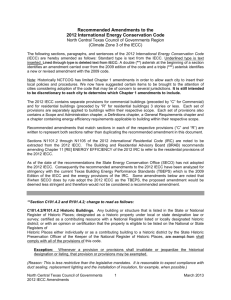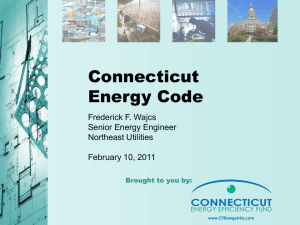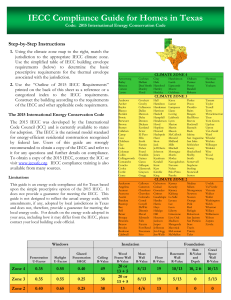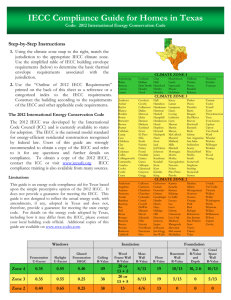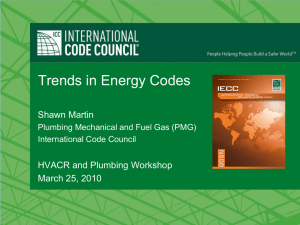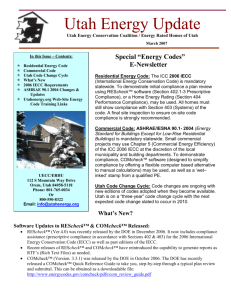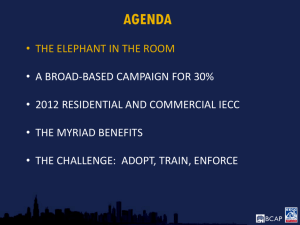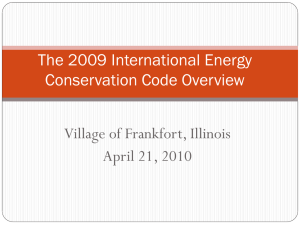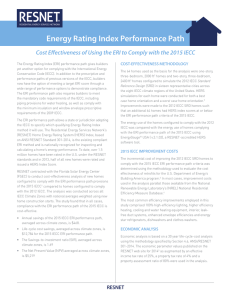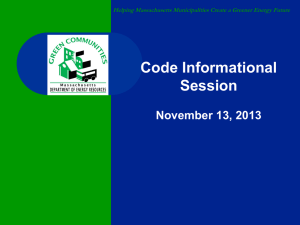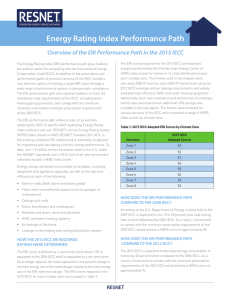IECC building code changes
advertisement
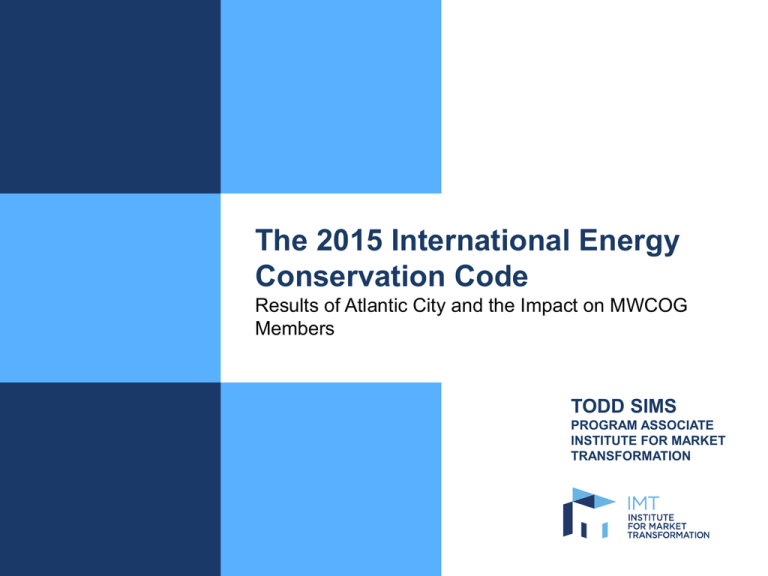
The 2015 International Energy Conservation Code Results of Atlantic City and the Impact on MWCOG Members TODD SIMS PROGRAM ASSOCIATE INSTITUTE FOR MARKET TRANSFORMATION AGENDA 1. Review of outreach efforts surrounding the Public Comment Hearing in Atlantic City 1. An overview of what the 2015 IECC is expected to look like 1. Looking ahead at the effects of cdpACCESS on the code development process Outreach Efforts - Raise awareness on the importance of code development process and upcoming deadlines to MWCOG - Facilitate travel scholarships allowing voting members to attend the hearing - Educate voting members on specific code change proposals - Provide rapid-response assistance during the hearings Outcomes COG members played an integral part of shaping the 2015 IECC. With 4 jurisdictions represented in Atlantic City, they played a key role in defending energyefficiency. You were the best represented region through the duration of the hearing. Result MWCOG voting members in Atlantic City: 1. 4 jurisdictions represented, ≈15 voting members 2. Sat through ≈100 hours of testimony over 6 days 3. Collectively COG voting members cast over 8,970 votes 4. Successfully defended energy efficiency against significant rollbacks Setting the Stage - Prior to Atlantic City, many experts expected significant rollbacks in EE to occur - Potential the 2015 IECC could have been less efficient than the 2012 IECC - Would have been first time in history - Could have failed DOE determination - “Holding the line” would have been considered a major victory Results of Atlantic City - “When you leave Atlantic City with more than you came with, you count yourself lucky” - Major “rollback” proposals were defeated (RE-166) - One major energy efficiency win (RE-188) - All-in-all: not significantly different energy savings than the 2012 IECC - However, the 2015 IECC will be clearer, more ‘user-friendly’, making it easier to realize those energy savings 2015 IECC – Residential Overview - Not many significant changes - Many of the proposals were fights over preventing backsliding - RE-166 would have re-instituted unrestricted equipment trade-offs - One major change: RE-188 - Institutes an Energy Rating Index compliance path Overview 2015 IECC – Residential Ch 1: Scope & Admin Scope and Administration - ‘Existing Buildings’, Historic Buildings’, and ‘additions, alterations, renovations, and repairs’ sections removed from Ch. 1 - Will be given a new section (likely a new Ch. 5) - Historic Buildings are no longer exempt from the IECC - Alterations and repairs must comply with IECC to the extent that compliance does not compromise the historic nature - § 104 has been revised to list and describe the required inspections 1. Footing and foundation 2. Framing and rough-in 3. Plumbing rough-in 4. Mechanical rough-in 2015 IECC – Residential Ch 2: Definitions - Definitions The following definitions have been added or revised for the 2015 IECC: - Continuous Insulation (ci) - ERI Reference Design - Fenestration - Historic Building - Insulated Siding - Skylight - Vertical Fenestration 2015 IECC – Residential Ch 3: General Requirements General Requirements - New climate zone added - § 301.4 will define what regions would constitute a “Tropical Climate Zone” - New section added for “insulated siding” - Lists ASTM C1363 as the test standard to determine R-Value of insulated siding 2015 IECC – Residential Ch 4: Energy Efficiency Building Envelope Provisions - New exemption to § R402.2.4 - Allows for vertical doors that provide access to conditioned space from unconditioned spaces to meet the fenestration requirements in Table R402.1.1 - New exemption to § R402.2.7 - Allows for floor framing cavity insulation not to be in contact with the underside of the subfloor decking as long as it is in contact w/ the topside of sheathing or continuous insulation installed on the bottom side of floor framing 2015 IECC – Residential Ch 4: Energy Efficiency (cont’d) - Building Envelope Provisions - - New section R402.2.13 - Addresses “walls with partial structural sheathing” Section R402.3.2 ‘Glazed fenestration SHGC’ - Revised to recognize dynamic glazing Significant revision to R402.4.1.1 ‘Air Barrier and Insulation Installation’ - Splits the ‘criteria’ column into separate ‘air barrier’ and ‘insulation installation’ criteria. Plus new criteria for ‘concealed sprinklers’, ‘walls’, ‘floors’, and ‘fireplaces’ Testing for building envelop air leakage under § 402.4.1.2 revised to require that all testing been done in accordance w/ ASTM E 779 or ASTM E 1827 Tight-fitting doors on factory-built fireplaces also be listed and labeled for the fireplace 2015 IECC – Residential Ch 4: Energy Efficiency (cont’d) - Mechanical Systems Provisions - - Change re: new equipment and combustion closets - Climate Zones 3-8 only: Atmospheric vented appliances inside the building envelope…must be in closet sealed and insulated according to Table R402.1.1 Duct insulation provisions: - Clarifies both supply & return ducts in attics must be insulated to a min. R-8, where 3 in. or > in diameter and R-6 where < 3 in. - Elsewhere must be insulated to a min. of R-6 where 3 in. or > and R-4.2 where < 3 in. The testing option of ‘rough-in test’ is listed before ‘post-construction’ test Change to § R403.6 ‘Equipment Sizing’ - “New or replacement heating and cooling equip. shall have an efficiency rating > or = the min. required by fed. law” 2015 IECC – Residential Ch 4: Energy Efficiency (cont’d) Hot Water Provisions - Change prohibits both gravity and thermo-syphon circulation systems - Change requires recirculation systems to be demandcontrolled - Hot water pipe insulation remains R-3 but the provisions have been simplified - ‘Maximum run length’ table deleted 2015 IECC – Residential Ch 4: Energy Efficiency (cont’d) - RE-188 - Only significant change to the 2015 IECC - A win for efficiency advocates - A new performance path compliance option and will become Sec. R406, ‘Energy Rating Index’ - Will set ERI score between 51-55 - Sets building-envelope stringency levels at 2009 IECC levels - Requires 3rd Party verification - ** IMT has several educational resources on RE-188 Performance Path Provisions RE-188 2015 IECC – Commercial Overview Overview - Several changes to the Commercial Code - Many of these yield incremental efficiency gains - The rest reorganize and clarify the code - Most changes concentrated in Lighting and HVAC Source: NEEP Presentation on ICC PCH Reactions and Next Steps by Don Vigneau and Kevin Rose 2015 IECC – Commercial Lighting - More requirements for daylighting controls and zones - Occupancy sensors in warehouses, lounges, etc. - Minimum skylighting area requirement extended - Commissioning of occupancy sensors and daylighting controls - Three new options to § C406: 1. Enhanced lighting controls 2. Dedicated outdoor air system 3. High efficiency service water heating Lighting Source: NEEP Presentation on ICC PCH Reactions and Next Steps by Don Vigneau and Kevin Rose 2015 IECC – Commercial HVAC, Water Heating, Lighting - HVAC, Water Heating, and Lighting Minimum HVAC, Water Heating, and Lighting Efficiency - Min. performance criteria were improved for the following to match ASHRAE 90.1-2013: AC/Heat pump Multi-zone VAV systems Energy recovery equip. Hot water system controls Kitchen exhaust flow Exterior lighting controls Refrigeration Lighting power densities Economizers and controls Electric transformers VAV fans Electrical motors Heat rejection equip. People movers 1/12 – 1 HP fans Lighting O&M manual Source: NEEP Presentation on ICC PCH Reactions and Next Steps by Don Vigneau and Kevin Rose What’s Next - Education and Training - Review supporting documents and resources - Train internal staff - Stay engaged - Support adoption of the 2015 IECC - No sweeping changes. BUT the changes that were made make the code clearer and easier to comply with. - Assess overlaps in policy - Current sustainable building policies may have overlap with the Code - Allows for more targeted policies - Get educated on cdpACCESS Next Steps cdpACCESS Overview - What is it? - cdp (code development process) ACCESS - NEW online voting portal - Administered by the International Code Council - What will it do? - Allow you to vote on code changes remotely - Removes cost and time burden of traveling to Public Comment Hearings - Significantly increase participation in code development cdpACCESS Next Steps - What effect will it have? - Make it easier for all code officials to participate in the process - BUT – efficiency opponents will be significantly advantaged when it comes to ‘voter outreach’ thanks to existing infrastructures - What are the next step? - Education - ICC hosting several webinars - IMT developing tools and guides - Plan for the future - First opportunity to use it: Group C Committee Action Hearing, April 27 – May 4, Memphis, TN Thank You TODD SIMS Program Associate Institute for Market Transformation todd@imt.org 202.525.2883 x321
